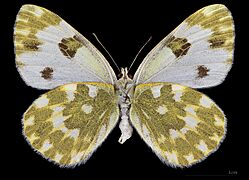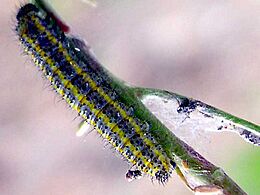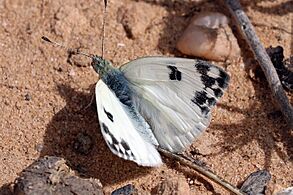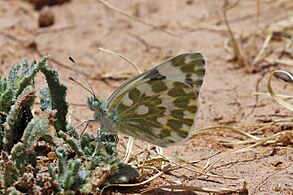Bath white facts for kids
Quick facts for kids Bath white |
|
|---|---|
 |
|
| Djebel Zaghdoud,Tunisia | |
| Conservation status | |
| Scientific classification | |
| Synonyms | |
|
The Pontia daplidice, also known as the Bath white, is a small butterfly. It belongs to the family Pieridae, which includes many yellow and white butterflies. You can find this butterfly in the Palearctic region, which covers Europe, Asia, and North Africa. It is quite common in central and southern Europe. Every summer, it flies north, sometimes reaching places like southern Scandinavia and even southern England.
Contents
What Does It Look Like?
The Bath white is a small butterfly. Its wingspan, which is the distance from one wingtip to the other, is about 45 to 50 millimeters.
You can easily tell it apart from other white butterflies. Just look at the underside of its hindwing. It has a cool pattern of greenish blotches. This unique pattern helps identify the Bath white.
Male vs. Female Butterflies
It's easy to tell the difference between male and female Bath white butterflies. You just need to look at the markings on their front wings.
- Males: The tip of their front wing is black. It has white spots and lines. There's also a black spot in the middle of the wing.
- Females: Females have all the same markings as males. But they also have an extra black spot near the bottom of their front wing. Females might also have a faint row of spots on the upper side of their hindwing.
Where Do They Live?
This butterfly is common in many places. You can find it in central and southern Europe, parts of Asia like Asia Minor, Persia, and Afghanistan. During the summer, they often fly north to new areas.
In Central Asia, the Bath white lives in places like Baluchistan, Peshawar, Chitral, and Kashmir. They also live along the Himalayas all the way to Darjeeling. It seems like this butterfly is slowly spreading its range westwards along the Himalayas.
You will usually find these butterflies in dry, open areas. They like rocky slopes or rough ground with not much plant growth. They also live in coastal sand dunes in the Mediterranean region.
What Do Caterpillars Eat?
The young caterpillars of the Bath white butterfly eat plants from the family Brassicaceae. This family includes plants like cabbage and mustard. The exact plants they eat can be different depending on where they live. Some common host plants include tower mustard (Arabis glabra) and sea rocket (Cakile maritima).
Different Types of Bath Whites
Scientists recognize different types of Bath white butterflies. These are called subspecies. They are slightly different groups within the same species. Here are some of them:
- Pontia daplidice daplidice (found in Mauritania, northern Niger, northern Chad, France, south-western Europe, North Africa)
- Pontia daplidice laenas (found in the Palestinian territories)
- Pontia daplidice aethiops (found in the highlands of Ethiopia, south-western Arabia, Near East, Afghanistan)
- Pontia daplidice moorei (found from Jammu & Kashmir to Northeast India, and Yunnan)
-
P. d. laenas from Jordan.
-
The underside of P. d. laenas from Jordan.
-
Two P. d. laenas butterflies mating in Jordan.
-
P. d. moorei from India.
An Old Butterfly Specimen
Did you know that the Oxford University Museum of Natural History has a very special Bath white butterfly? It's a pinned specimen from the year 1702! This makes it the oldest insect specimen still on its original pin that we know of.
Images for kids











